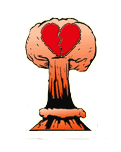1986 gets a lot of credit for being the best year in comic books ever. That’s when Alan Moore’s Watchmen appeared, Frank Millar’s Dark Knight Returns showed up and the black and white boom reached it’s apex with the publication of Dark Horse’s first comic books Boris the Bear and Dark Horse Presents. Oh, and there was some little event thing known as Crisis on Infinite Earths that wrapped up. But is it the Best Year Ever?
The reason I’m contemplating this is because I just read an article by Chris Roberson about the Squadron Supreme mini series (one of my favorite comics) at RevolutionSF. They’re doing a series of web-essays counting down the best comic books of the best year in comics, 1986. They’re now moving into the top ten.
When it comes to looking at trends historically, I tend to feel somewhat apprehensive about making grand sweeping statements. It would be like saying WWII was best war ever! Well, maybe not that sweeping but you get my point. Many of the RevolutionSF essays bring up earlier 80’s comics just to get the “best year” into context. I mean no comic is an island, right? (OK, maybe “Reagan’s Raiders” is, but that’s it.) Plus, there’s an article on the awful Secret Wars II. So what’s going on?
I think what the RevolutionSF crew is really getting at is that 1986 is an important turning point. The black and white comic wave crested, “grim and gritty” took off, and traditional (i.e. Silver Age) superheroes storytelling was out. They “killed off” the old style Superman in "What Ever Happened to the Man of Tomorrow," and replaced him with John Byrne’s less powerful “Man of Steel.” Heroes had to have real problems and still be relatable. It wasn’t only Superman either; DC took the opportunity to refurbish many characters as Crisis on Infinite Earths concluded. I’ve heard this trend at the distinguished competition called the Marvelizing of DC comics.
There was some negative fallout from 1986 as well. In regards to Crisis on Infinite Earths, there was no editorial control over the comics published. This series was meant to clean up the DC Universe but in the end it made things worse as stories immediately began to contradict the new earth created at the end of the mini-series. That’s why nowadays these big company wide crossovers have a producer-type, who manages the whole event and ensures that discrepancies and errors aren’t allowed. Secret Wars II is another example of just how bad company wide crossovers can get. With this event playing out in a bazillion different titles, it was really a 30+ issue miniseries and since it made money it became the new crossover event standard. Just look at House of M and you’ll see it’s still haunting us today. I could go on and on randomly here, but read the essays at RevolutionSF and form your own opinions.
I was there as a teenage fan back in 1986. I was there for Watchmen, Dark Knight, Squadron Supreme, and the rest. I knew something exciting was going on and it was a fantastic time to be a reader. Comics even received positive attention in the media. But sadly, I believe what really made 1986 the best year in comics is that nothing really came after it except Sandman. Once the memorable ’86 titles came and went, comics seemed to creatively flounder. Plus, we still had to get through the speculator boom “argh.”
Saturday, July 7, 2007
1986... the best year in comics?
Labels:
comics,
culture,
Dark Horse,
DC Comics,
Marvel Comics,
Superheroes
Subscribe to:
Post Comments (Atom)







6 comments:
Naw, the best thing about 1986 is that I was in college, you were havin' fun in HS w/your friends and Fester was graduatin' as Valedictorian.
But Sandman wascool. Thanks for letting me read it!
1986. It was the best of times. It was the worst of times. I think you are right about 1986. It might also be generational too because I enjoyed reading Little Lulu and Richie Rich more than Superman and Batman when I was growing up, so most of the upheavals regarding superheroes didn't apply to my comics.
Having missed out on the Dark Horse genesis and all that it meant while later being reintroduced to the current "underground" scene by Swinebread, I would say that the RecolutionSF folks are looking at the "best year" from a very particular perspective.
(Not to mention the subversive syndicated comics like Ted Rall, Tom Tomorrow, and Tom and Dancing Bug which I really enjoy that fall outside the standard newsrack comics.)
1986 was also the year of Art Adams' Longshot. What ever happened to that guy. On the bad side: with the departure of Bill Sienkiewicz, 1986 could be called the beginning of the New Mutants downward spiral into Liefeld-land (and only a year after Adams' beautiful NM special #1).
LB – sure!
Snab – Most folks see comics through Comic Books eyes or Comic Strip eyes and disregard the other form. They only place where I’ve scene real critical analysis of both is the Comics Journal. Also, few companies like Dark House and Fantagraphics, which produce reprints of comic strips, understand the connection.
Then there’s the whole underground comics scene…
Akronbey – Yes, Longshot is #39… But I agree that there was a sort of flameout after 1986
1986 was the end of my first and the beginning of my second year at OSU and a wonderful year for crises. Actually, the real fun didn't begin until 1987, but I was awash in obsessions then.
I guess I missed out on a lot. I only wish I had missed out a bit more on the popular music scene then.
Yeah, I quit Pop music the very next year, so I understand
Post a Comment